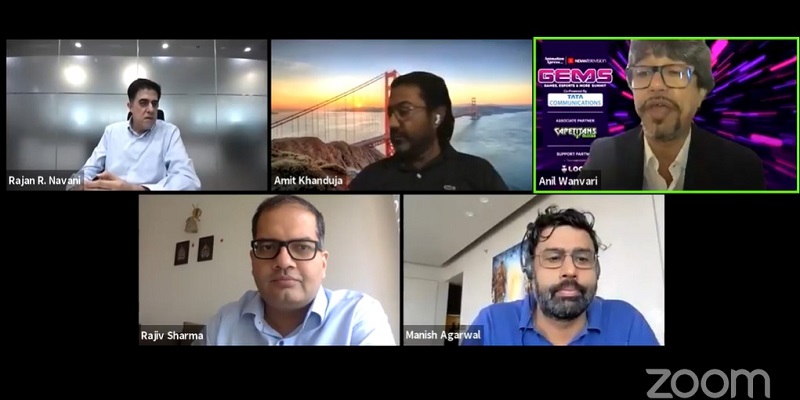Ranging from games on phones to console and PC titles, the country has taken to gaming with great enthusiasm and this industry has evolved at a fast pace in the passing months. The gaming industry is undergoing a massive evolution and one of the recent stimuli has been the pandemic, lockdown, interests of users into gaming, and so on.
The third panel of GEMS 2020 was an insightful discussion on the developments and transformation of the Indian gaming ecosystem into the mainstream, with help of the rising users, investors, and the government interests to galvanize the growth. Panelists included SBICAPS Securities head of equity research Rajiv Sharma, Nazara Technologies chief executive officer Manish Agarwal, Reliance Entertainment – Digital chief executive officer Amit Khanduja, Jetsynthesis vice-chairman and managing director Rajan R Navani and the moderator for this session was Indian Television Dot Com Group CEO and editor-in-chief Anil Wanvari. They shared their insights on the direction where the Indian gaming industry is going and how the coming years will be like.

India has the second-highest population in the world, with over 1.3 billion inhabitants as of the beginning of 2020. This means that there is a massive untapped base for the gaming industry in India which, if used well, can make a valuable contribution to the economy. Over the past few months, the sector has witnessed massive growth and industry experts along with the government plans to make the ecosystem favourable for business, job creation, and so on.
One of the crucial reasons for the growth of the sector is also the rush of investors. Pouring light on how the industry has witnessed the rush of investors in the past few months Sharma shared, “Gaming is an evolving section. Investors are all looking at things that start small but grow out to be very big.”
Joining the statement Agarwal pointed out that there are two ways investments are happening – one is private and the other one is public. He added, “The private money is chasing the Indian gaming companies like never before since eight to nine months; for example MPL, Dream 11, WinZO. After COVID there is an immense amount of interest of global and local investors to come into gaming. The velocity of discussions, frequency of discussion, depth of discussion have increased enormously and immensely. The efforts get accentuated when you are talking to somebody who is not a gaming consumer themselves vs when you look at a Nordic country or the US or Hong Kong, the investors of the public market have made money in gaming as most of them are gamers, and it’s much easier to make them understand the consumer psychology.”
There are four constituencies and stakeholders. There are domestic investors, foreign investors, consumers and parents and then there is the government. “For foreign investors, there is no requirement of educating them as they are already aware and all the push is towards the domestic investors. The importance of all constituencies is the government because the COVID has done three things on the consumers. One – the screen is inevitable. The family time or the friends time and playing games together have really kind of brought a lot of elders into gaming (who used to think that games are kids and not them). They are understanding PUBG tournament, FreeFire Tournament. The government constituency is where we need to evangelise, create awareness, create a framework policy,” Agarwal added.
For framework policy Nawani and Agarwal are currently working with FICCI, CII, IMAI, to interact with six ministries. They had to talk to many stakeholders within the government to get a uniformity that also includes state government. “We are a federal state and gaming is a federal subject and for that perspective, a lot of effort is happening which will start reflecting in the next two months under the leadership of few of us,” added Agarwal.
On one side it is investors, government policies and on the other side, it is content. Kanduja highlighted the fact that users’ interest for good quality content has been skyrocketing. He said, “Gaming and esports are connected. We are seeing significant growth in the sector and we are also seeing a lot more indie developers who are entering the ecosystem with a good source of ideas. Along with that, we all have to understand to create good quality games. If we fail to do so then these players will not likely play Indian games and will prefer international games. Consumers are smart. They play international games because of the quality of work. If you check the top 20 games on the google store, there are mostly international brands. LUDO and Carrom are traditionally global games and people are playing them and that is what we need to create – games which are compelling, engaging and retain the places and provide the users to perform.”
Why are we not able to increase the size and scale of these companies in India? According to Nawani, India’s perspective of video games work differently for great quality content. India needs to scale up capital wise. He cited an example of the popular game Angry Bird which became successful at the 52nd time. “The cost of building great quality games, the cost of the creative industry, the cost of getting great global talent, the cost of acquiring the right set of users with a large marketing budget, actually requires a large transformation scale. The industry needs to be viewed, to create any dent globally because the rest of the world is matured there.”
The Indian gamer community is going to be different from what rest of the world has seen its multi-cultural influences and more. We have to think local and go global for the growth of the gaming sector. As Agarwal opined while commenting on the Indian gaming journey: “Gaming is bigger than Bollywood already! Get over Bollywood syndrome, get over China syndrome, because we are here to write the decade of the Indian gaming.”

